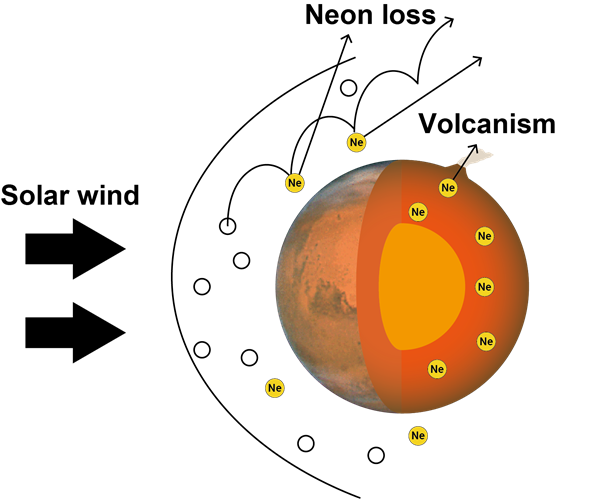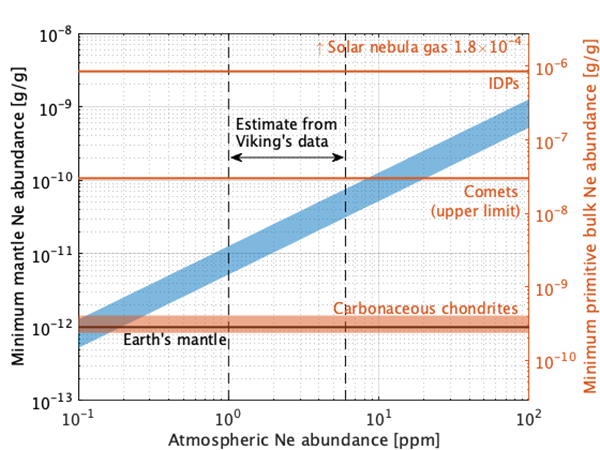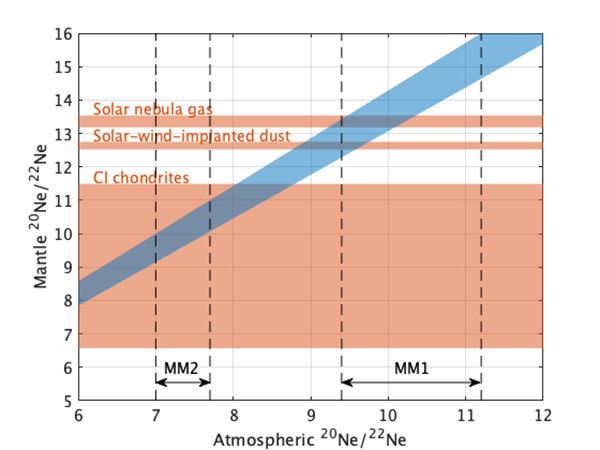New research showed that a light noble gas, neon in Mars atmosphere, can serve as a probe for its deep interior. Using data of past and recent Mars missions, Viking and MAVEN, the researchers found that Mars interior is richer in neon than Earth's and likely in other volatiles such as water. The researchers conclude that future in situ measurements of atmospheric neon is crucial for understanding the origin of Mars and its early habitable environment.

Deep planetary interiors record the history of their formation. For instance, the discovery of Earth's deep mantle neon, which is isotopically distinct from the atmosphere, has been interpreted as a signature of volatile elements directly captured from solar nebula gas in the planet formation stage. This is in contrast with surficial (atmosphere and oceans) volatile elements which were likely sourced from primitive bodies in the early Solar System. The presence or absence of similar signatures in other terrestrial planets (Mercury, Venus, and Mars) is crucial for understanding the formation processes of planets and their habitability. Yet, direct measurements of trapped volatile elements in deep planetary interiors beyond Earth are extremely difficult because of limited access.
New research led by Hiroyuki Kurokawa, specially appointed assistant professor at the Earth-Life Science Institute (ELSI) at Tokyo Institute of Technology, utilised that because Mars does not have a magnetic field, Mars atmosphere is being continuously lost to space due to the direct interaction with the solar wind. The research team calculated data from NASA Mars MAVEN orbiter to determine that lifetime of light noble gas, neon, to be only about 100 million years, suggesting neon we see in Mars atmosphere today should be a component recently degassed from its interior by volcanism. Thus, Mars' atmospheric neon can serve as a probe for its deep interior (Figure 1).

The abundance of neon in Mars' atmosphere has been estimated from data obtained by NASA's Viking lander. Using the atmospheric abundance, the researchers estimated the abundance of neon in Mars' interior. The informed value is higher than that of Earth's mantle, suggesting that Mars' mantle is rich in neon (Figure 2). Because possible sources of neon (solar nebula gas and primitive bodies in the early solar system) are rich in other volatile elements as well, Mars likely acquired large amounts of other volatiles such as water, carbon, and nitrogen as well.
This study also developed a methodology to determine the source of Mars' neon from the measurements of the isotopic composition of atmospheric neon (Figure 3). The isotopic composition has never been measured by past Mars exploration missions, but the researchers state that such measurements are particularly important for unveiling the origin of Mars and its early habitable environment.

The difficulty in measuring the isotopic composition of Mars' neon by previous missions is a high concentration of argon in the atmosphere. Argon interferes with the signal from neon in measurements by mass spectrometers. To resolve this problem, the researchers are developing a system to measure Mars' atmospheric neon with a mass spectrometer equipped with a permeable membrane to separate neon from argon. They propose this system for JAXA's future Mars landing missions. Moreover, the Mars Sample Return mission by NASA and ESA may, if enough atmospheric gas is sampled with soils, provide another opportunity to measure Mars' atmospheric neon.
| Journal | Icarus |
| Title of the paper | Mars' atmospheric neon suggests volatile-rich primitive mantle |
| Authors | Hiroyuki Kurokawa1,*, Yayoi N. Miura2, Seiji Sugita3, Yuichiro Cho3, François Leblanc4, Naoki Terada5, Hiromu Nakagawa5 |
| Affiliations | 1. Earth-Life Science Institute, Tokyo Institute of Technology, Japan 2. Earthquake Research Institute, The University of Tokyo, Japan 3. The University of Tokyo, Japan 4. LATMOS/CNRS, Sorbonne Université, UVSQ, France 5. Tohoku University, Japan |
| DOI | 10.1016/j.icarus.2021.114685 |
| Online published date | 4 September, 2021 |
